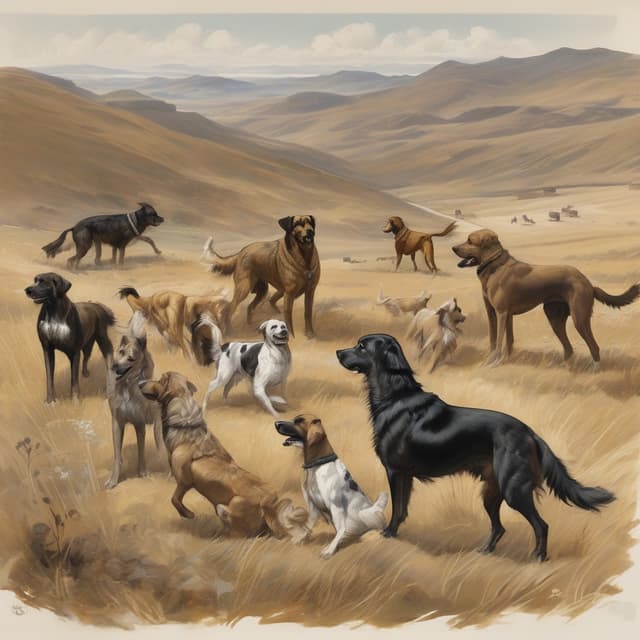
| Impact | Facilitated the rise of early civilizations across Eurasia |
| Diversity | Diverse array of dog breeds, distinct from those familiar to our timeline |
| Subspecies | |
| Domestication | Thousands of years ago by ancient nomadic pastoralist cultures in Central Asia |
| Historical Uses | Herding • Guarding livestock • Pack animals for transportation |
Dogs, scientifically classified as the subspecies ''Canis lupus familiaris'', are a domesticated form of the Gray Wolf that have coexisted with humans for thousands of years. Unlike in our timeline, where dogs were first domesticated by hunter-gatherer societies in Europe and the Middle East, in this alternate history, dogs were first domesticated by ancient nomadic pastoralist cultures in Central Asia.
The story of dog domestication in this timeline begins around 8,000 years ago on the vast grasslands of Central Asia. As nomadic herders and pastoralists developed cultures centered around raising livestock like sheep, goats and horses, they encountered populations of wolves that were attracted to the abundant food sources provided by the herds.
Over generations, the most docile and least aggressive wolves were gradually integrated into these pastoralist societies, taking on roles as livestock guardians, herding assistants, and even pack animals. This process of co-evolution between humans, dogs, and horses allowed these nomadic cultures to thrive in the challenging environments of the Central Asian steppes.
As the pastoralist lifestyle spread across the Eurasian continent, the populations of domesticated dogs diversified into a wide array of regional dog breeds adapted to different climates, terrains, and uses. Some dogs were bred primarily for their size and strength to guard large herds of livestock, while others were selected for speed and endurance to aid in the transportation of goods and people.
Many of these ancient dog breeds, such as the massive Tibetan Mastiff, the nimble Saluki, and the hardy Samoyed, have no direct parallels in the dog breeds of our timeline. They reflect the unique evolutionary paths shaped by the needs and environments of the diverse pastoralist cultures that domesticated them.
The close relationship between humans, horses and dogs was a key driver in the rise of the first major civilizations in Eurasia. Nomadic pastoralists used their canine companions not only to manage their herds, but also to support the transportation of goods, people and information across vast distances.
As these pastoralist cultures came into contact and intermixed with the first settled agricultural societies, dogs played a vital role in facilitating trade, the spread of technologies, and the exchange of cultural ideas. Their versatility as guards, pack animals, and even sources of food helped nomadic groups integrate with their more sedentary neighbors.
In many ancient Eurasian civilizations, dogs were revered for their loyalty and utility, with certain breeds attaining significant social status. Artifacts, artwork and writings from these societies frequently depict dogs in roles ranging from loyal companions to sacred protectors of the home and community.
While the specific breeds of dogs found in this alternate timeline differ from those we know today, dogs overall have retained their importance as companions, workers, and cultural symbols for human societies across the world. Their co-evolution with humans over millennia has made them an integral part of the human experience, transcending geographical and historical boundaries.
Even as traditional pastoralist lifeways have given way to more modern urban and agricultural societies, dogs continue to play vital roles - from herding livestock to providing emotional support, from guarding homes to participating in sports and entertainment. The deep bond between humans and canines remains a universal constant, though the nature of that bond has evolved along with our civilizations.